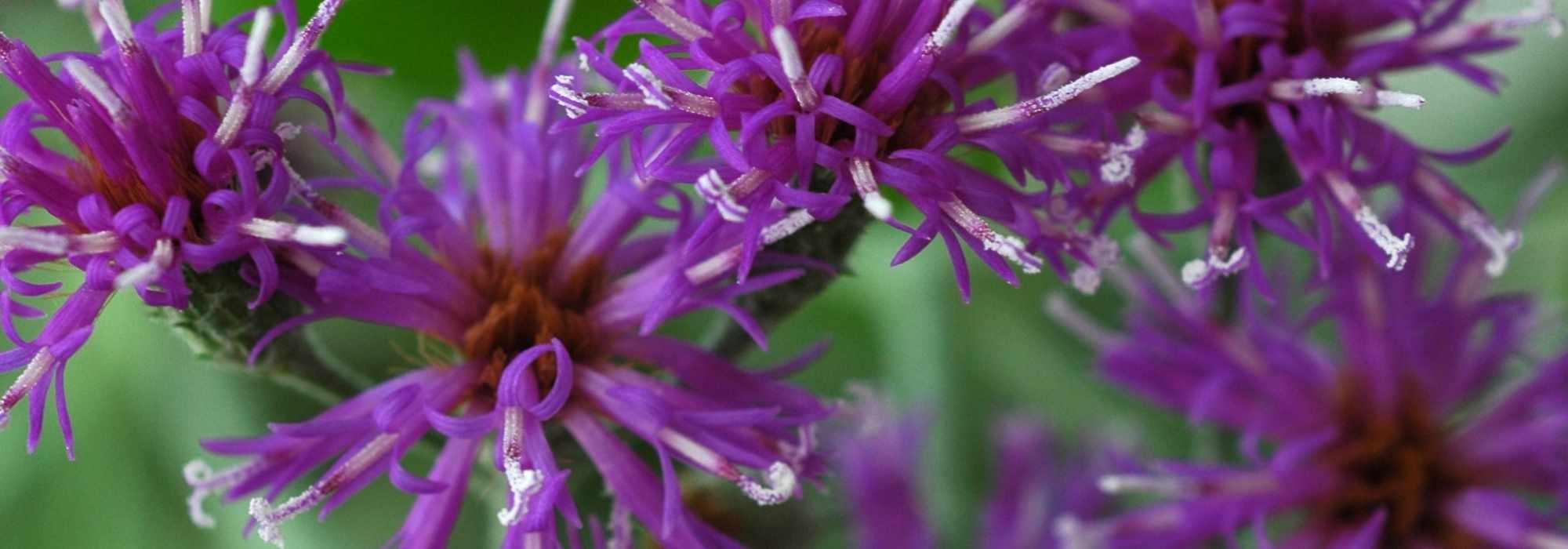
Vernonia: planting, growing
Contents
Vernonia in a nutshell
- Vernonia is an impressive perennial with abundant summer flowering
- It blooms profusely in large umbels of flowers that are often purple, sometimes white
- It thrives in rich, cool soils
- Very hardy, it withstands harsh winters without fail
- It is ideal for the edges of water features, but also adds verticality to the back of borders
A word from our expert
Vernonia is a beautiful perennial with a somewhat wild appearance that rewards us with a lovely summer, sometimes autumnal, flowering, featuring corymbs of small purple or white pom-poms reminiscent of eupatoriums. These small, dishevelled heads can reach up to 2 m high for the giants Vernonia noveboracensis and Vernonia crinita ‘Mammuth’. The genus also includes some sublime varieties that undoubtedly deserve to be better known, such as Vernonia crinita var. ‘Alba‘, a form with white flowers! The leaves of the common vernonia (Vernonia amygdalina, locally known as Ndolé) growing in tropical Africa are said to contain numerous benefits.
This perennial, native to the wet meadows of North America, thrives in rich, cool soils, even clayey and marshy ones, where it grows vigorously. Not demanding and very hardy, Vernonia can also thrive in any ordinary soil, provided it is kept moist. Deciduous, it re-emerges vigorously each spring after a simple cutback in early winter.
Preferring humid locations, it flourishes by water bodies, in the cool areas of natural gardens where it forms beautiful structural clumps. With its upright silhouette, it is the ideal candidate for the back of borders or near water bodies, where it will add significant verticality. Its natural character, sometimes ignoring imposed boundaries, also makes it suitable for flowering meadows.
Discover this robust, melliferous, and charming plant that is little used in our French gardens!
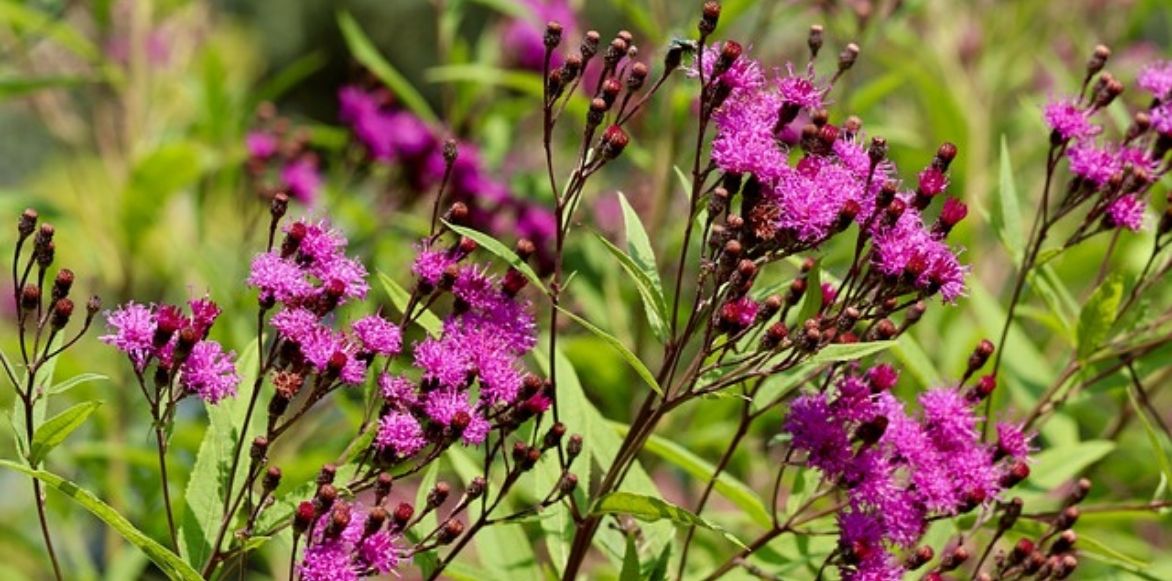
Vernonia gigantea
Description and botany
Botanical data
- Latin name Vernonia
- Family Asteraceae
- Common name ironweed
- Flowering July to October, depending on the varieties
- Height 1.20 m to 2 m
- Exposure Sun
- Soil type rich and light, clayey, cool
- Hardiness -20°C
Vernonia, or ironweed, is a perennial plant belonging to the large family of Asteraceae, closely related to asters. The genus Vernonia includes nearly 1000 species, primarily herbaceous perennials, but also shrubs, and even some undershrubs. They are mainly native to the humid meadows of tropical regions around the globe. Some hardier varieties come from the meadows and riverbanks of North America.
In France, we mainly find hardy perennials from these North American meadows, such as Vernonia noveboracensis and Vernonia crinita, two tall species with beautiful cultivars, and Vernonia baldwinii, another robust ironweed. Vernonia gigantea is a giant species. Vernonia noveboracensis and Vernonia crinita come in interesting varieties with purple flowers, such as Vernonia crinita ‘Mammuth’, sometimes white like Vernonia crinita var. ‘Alba’ or Vernonia noveboracensis ‘White Lightning’.
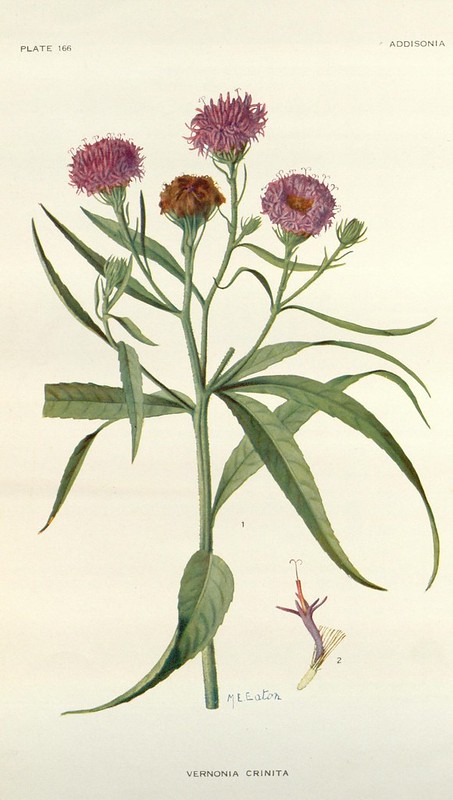 Vernonia crinita, botanical plate
Vernonia crinita, botanical plate
Vernonia develops from a powerful rhizomatous stump. It grows quite rapidly, but like many perennials, it needs two years to establish well. The plant quickly forms a beautiful erect clump that can reach nearly 3 m in height and 80 cm in spread. From its woody stump, fine but robust stems emerge in spring, stiff and sparsely branched. The upright stems bear dark green to glaucous green deciduous leaves. The leaves are 12 cm long and 5 cm wide, alternate, simple, entire or dentate, and narrow, lance-shaped. They are sometimes covered with a fine white velvet.
The abundant flowering begins in July and continues until October, or even November, depending on the varieties and climate. It appears as numerous fluffy small heads gathered in terminal corymbs at the ends of the stems. These large elegant umbels bloom profusely above the fine foliage, giving the plant a light and airy appearance. The flowers radiate in small fluffy and bright pom-poms, white, purple, mauve, or lilac, depending on the varieties, turning rusty with age, hence its Anglo-Saxon nickname ‘ironweed’.
They consist of tubular florets arranged in very tight rays. They are characterised by a feathery appearance reminiscent of eupatorium flowers, ageratum, or some asters. These small fluffy balls are highly melliferous; they are constantly crowned by butterflies, bumblebees, and bees.
The fertilised flowers turn into fruits containing seeds that will delight goldfinches at the end of the season. If conditions are favourable, they may reseed wherever they please, which can make the plant somewhat invasive.
 Vernonia marginata, Vernonia elliptica (Photo: F.K. Starr), and Vernonia cinerea (Photo: HQ)
Vernonia marginata, Vernonia elliptica (Photo: F.K. Starr), and Vernonia cinerea (Photo: HQ)
“`
Read also
12 perennials for heavy, wet soilMain species and varieties
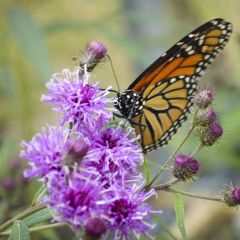
Vernonia noveboracensis - Ironweed
- Flowering time September to November
- Height at maturity 2 m
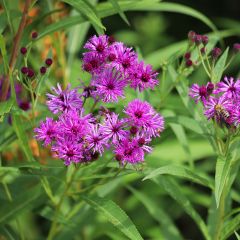
Vernonia crinita - Ironweed
- Flowering time September to November
- Height at maturity 2 m
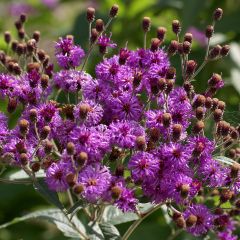
Vernonia baldwinii - Ironweed
- Flowering time August, September
- Height at maturity 1,20 m
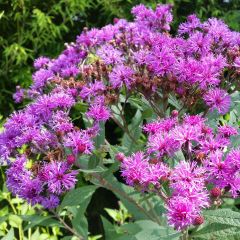
Vernonia crinita Mammuth - Ironweed
- Flowering time August to November
- Height at maturity 1,70 m
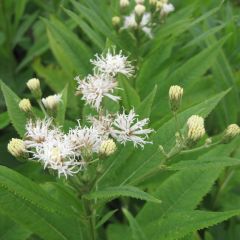
Vernonia crinita var. alba - Ironweed
- Flowering time August to November
- Height at maturity 2 m
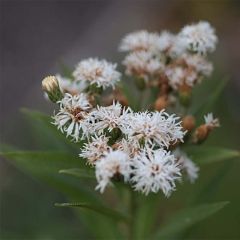
Vernonia noveboracensis White Lightning - Ironweed
- Flowering time September to December
- Height at maturity 2 m
Discover other Vernonia - Bitterleaf
View all →Available in 1 sizes
Available in 1 sizes
Available in 0 sizes
Available in 1 sizes
Available in 1 sizes
Available in 1 sizes
Available in 1 sizes
Available in 1 sizes
Available in 1 sizes
Available in 2 sizes
Planting
Where to plant Vernonia?
Vernonia is a very hardy perennial capable of withstanding negative temperatures down to -20°C in well-drained soil. Easy to care for, it establishes itself easily in all our regions, even in the heart of the hottest summers, provided the soil remains cool and sufficiently deep.
While it accepts all types of soil, as long as they are not too dry, even clayey, Vernonia thrives best in rich, deep, well-drained, and cool soils. For this native of the rich North American prairies, a good humus-bearing garden soil that is always moist will make it happy, especially in summer if drought sets in. It will struggle to thrive in dry gardens. However, it will be wary of overly suffocating soils.
For a beautiful flowering display, choose a location that is preferably well-sunny. It tolerates partial shade in our warmest regions.
It establishes itself slowly but surely. The plant tends to self-seed very easily. This is a quality for adorning a flowering meadow, but it can pose a problem in a border. If it is happy, it sometimes exceeds the boundaries set for it. We recommend reserving it for large naturalistic gardens and natural meadows, where its spread will not be a concern. This tall, hardy perennial adds verticality to the edges of banks or ponds.
Reaching up to 2.5 m in height, it will also look wonderful in a border at the back, provided the soil never dries out in summer, adding height, relief, and lightness.
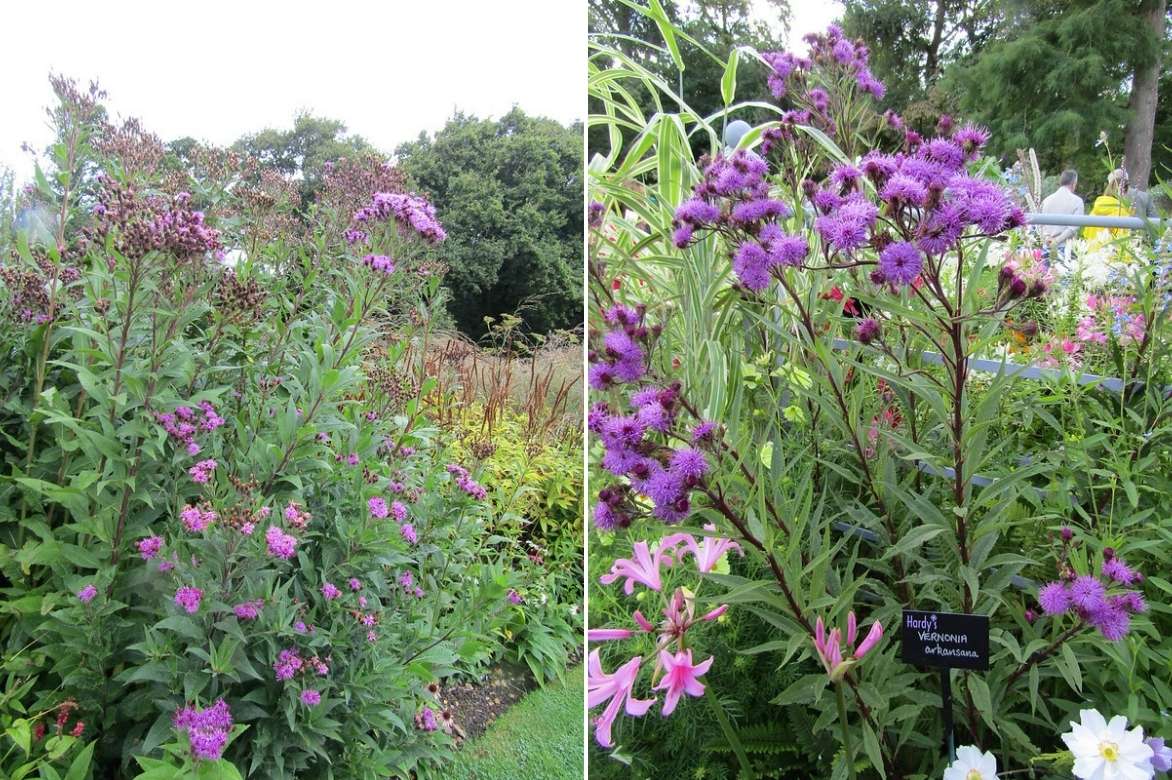 Vernonia arkansana (Photos: Leonora Enking)
Vernonia arkansana (Photos: Leonora Enking)
When to plant?
Vernonias in pots should be planted in spring, generally in March-April, or in autumn, outside of frost periods.
How to plant it?
In overly heavy or compact soil, incorporate leaf compost and coarse sand into the planting soil to improve drainage. We recommend a planting density of 3 to 5 plants per m² to achieve a beautiful mass effect.
-
- Dig a hole two to three times wider than the root ball
-
- Spread a layer of gravel at the bottom
-
- Place your plant
-
- Backfill with garden soil mixed with a bit of compost and sand
-
- Lightly firm down
- Water generously
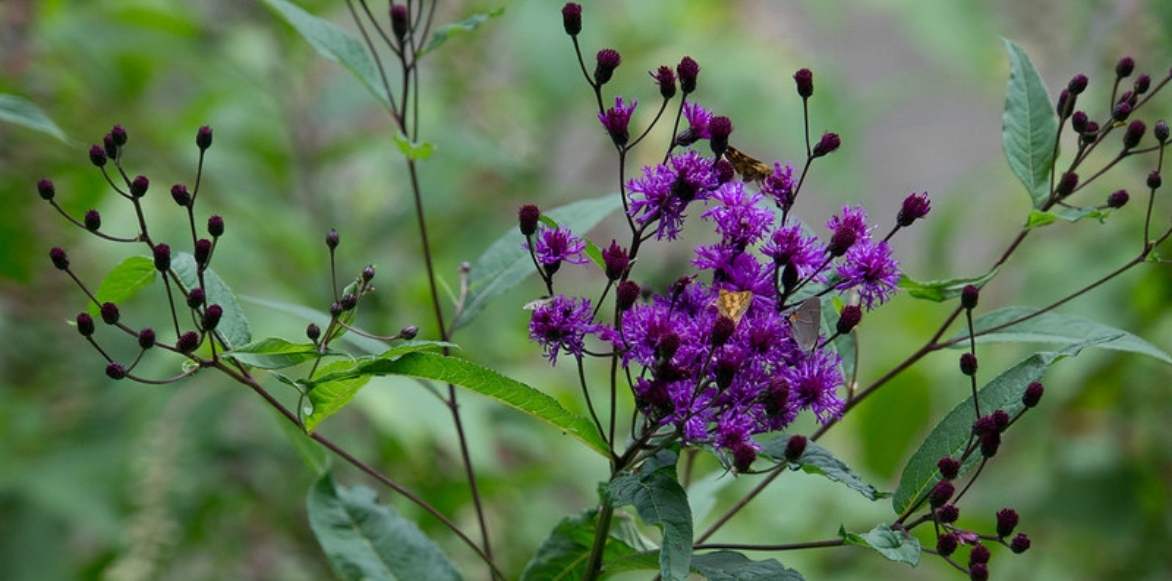 Vernonia noveboracensis
Vernonia noveboracensis
Read also
Gardening in heavy, wet soilVernonia care
Once well-rooted, Vernonia requires little care as long as the soil remains moist in summer. Monitor watering during the first year after planting.
Mulch to limit water evaporation and thus reduce watering. Regularly remove faded flowers to encourage new flowering and prevent self-seeding. Cut back the clumps to ground level after flowering. In spring, clean the stump to remove dry parts. In ordinary soil, consider adding a small amount of compost in early summer to support flowering and in autumn to promote growth.
Divide clumps that have become too large every 3 to 4 years.
In spring, watch out for slugs that love the young foliage: discover our tips for combating their attacks!
Multiplication
Vernonia can be propagated by sowing and by propagation by cuttings in early summer, but we recommend clump division in spring, after the frosts, as it is much easier and quicker.
- Dig up the clump using a fork
- Separate it into several parts, ensuring each has roots
- Replant immediately
- Water
Pairing Vernonia in the garden
Vernonia is a must-have in natural and wild gardens. Its tall, floriferous clumps create pastoral scenes from summer to early autumn, always adding colour, light, and plenty of verticality to a setting. This vigorous perennial pairs well with a multitude of plants that also enjoy cool soils.
It is ideal near a water feature, where it complements other perennial wetland plants such as loosestrifes or lysimachias, Goat’s beard, Filipendula rubra ‘Venusta’, or Euphorbia palustris. Plant it alongside lovely eupatoriums (Eupatorium maculatum ‘Atropurpureum’), Lythrum salicaria, Euphorbia palustris, and yellow-spiked ligularias for a contrasting effect.
Its expansive nature also allows it to be planted in a flowering meadow, where its melliferous presence will attract pollinators.
Its tall stature also structures the back of perennial borders alongside some Buenos Aires vervains, mauve-flowering asters, Rudbeckia maxima, and large grasses such as Miscanthus, Panicum, or Stipa tenuifolia. Choose from the tallest varieties, which can reach up to 2 m. The bright mauve-lilac hue of its flowers will highlight grey-foliaged plants such as hostas or wormwoods.
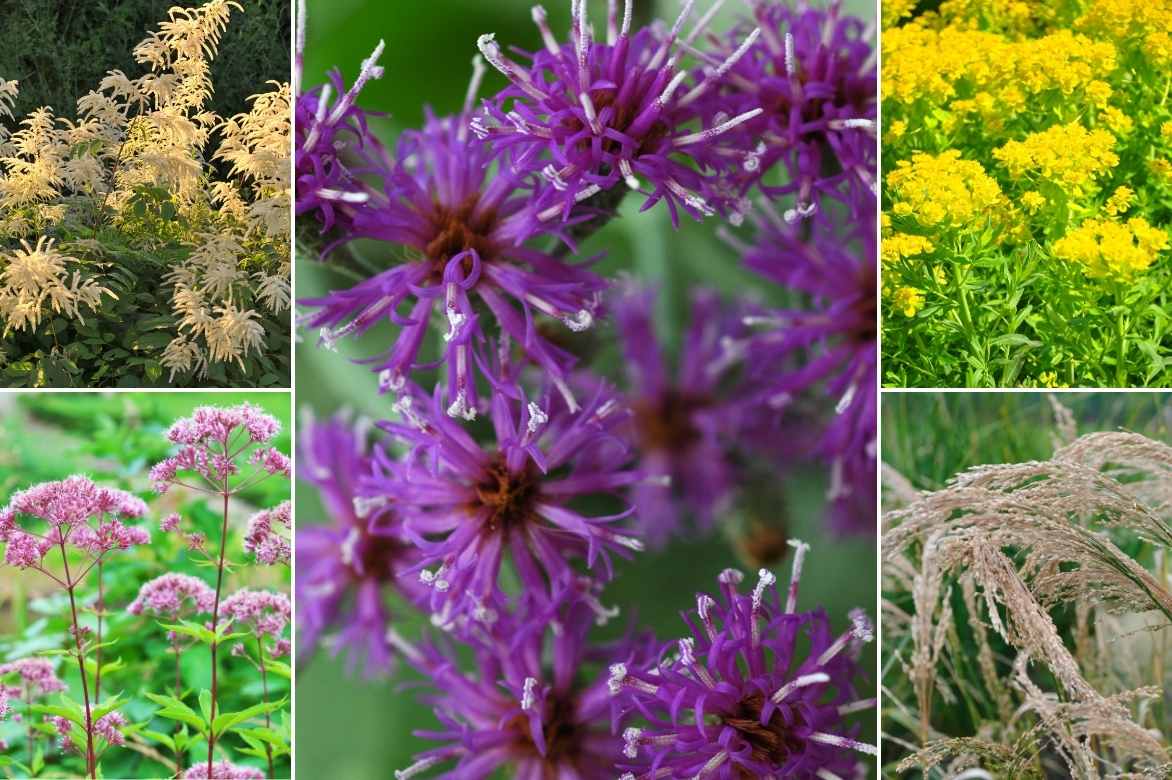 Vernonia balwinii, alongside the light blooms of Aruncus palustris, Eupatoriums, Euphorbias palustris, and Panicums.[/caption>
Vernonia balwinii, alongside the light blooms of Aruncus palustris, Eupatoriums, Euphorbias palustris, and Panicums.[/caption>
Useful resources
- Subscribe!
- Contents
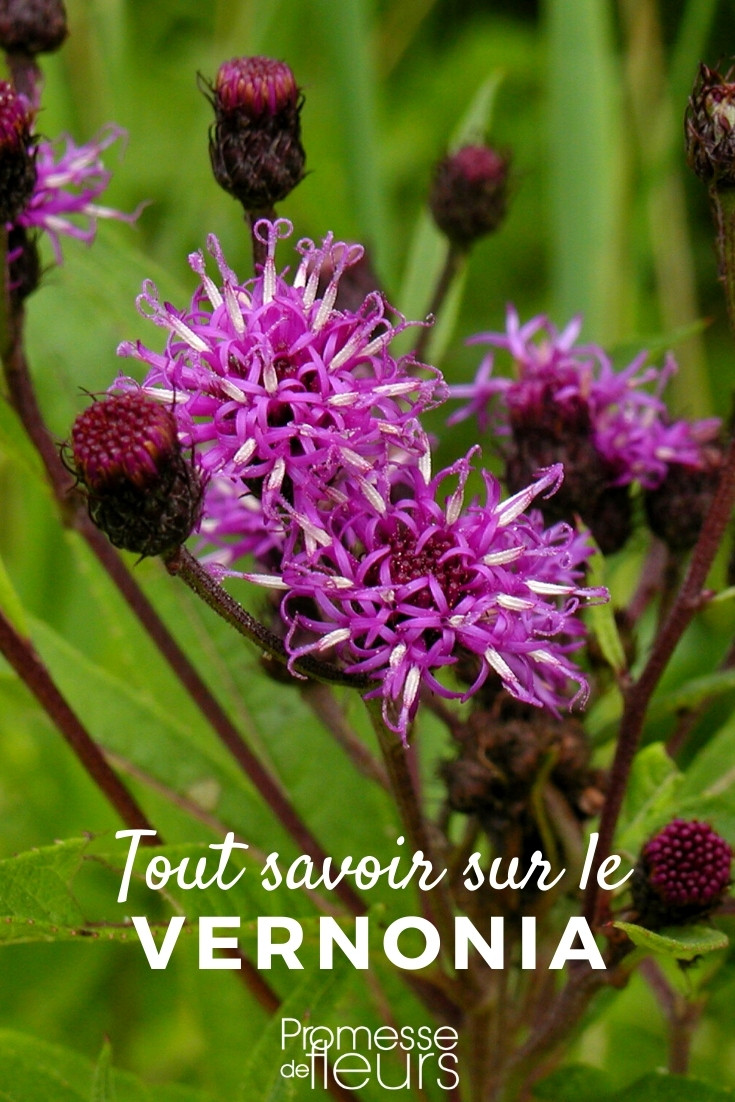































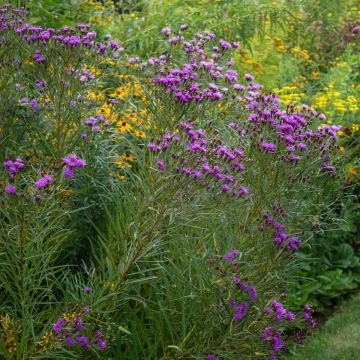

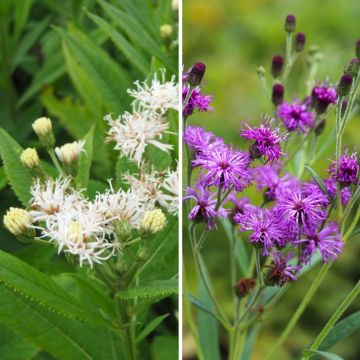
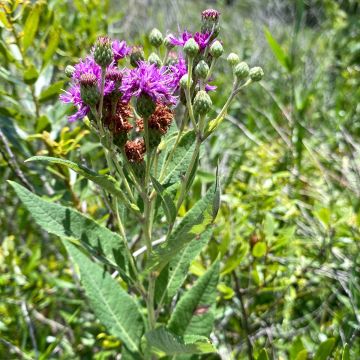

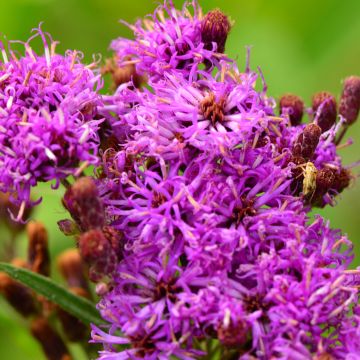
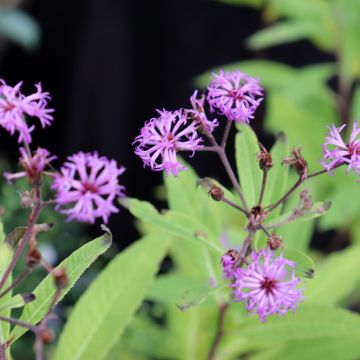
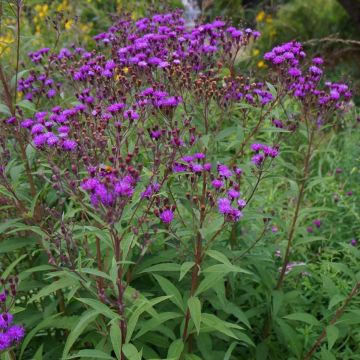


Comments